The Role of International Organizations in Sustainable Tourism Policy
VerifiedAdded on 2023/06/10
|9
|2213
|297
Essay
AI Summary
This essay examines the concept of sustainable tourism development within the context of international tourism policy, emphasizing the roles of international and supranational organizations in fostering economic growth while protecting the environment. It discusses the increasing significance of tourism for national and international economies, highlighting the importance of balancing recreational and business opportunities with sustainable practices. The essay explores various theories supporting sustainable tourism, such as resource efficiency and biological diversity, and analyzes the contributions of organizations like the World Tourism Organization (WTO), the United Nations Environment Program (UNEP), and the World Travel and Tourism Council (WTTC) in promoting sustainable tourism operations through policies and frameworks. It concludes that international cooperation and the implementation of sustainable tourism policies are essential for achieving long-term sustainable development in the tourism sector.
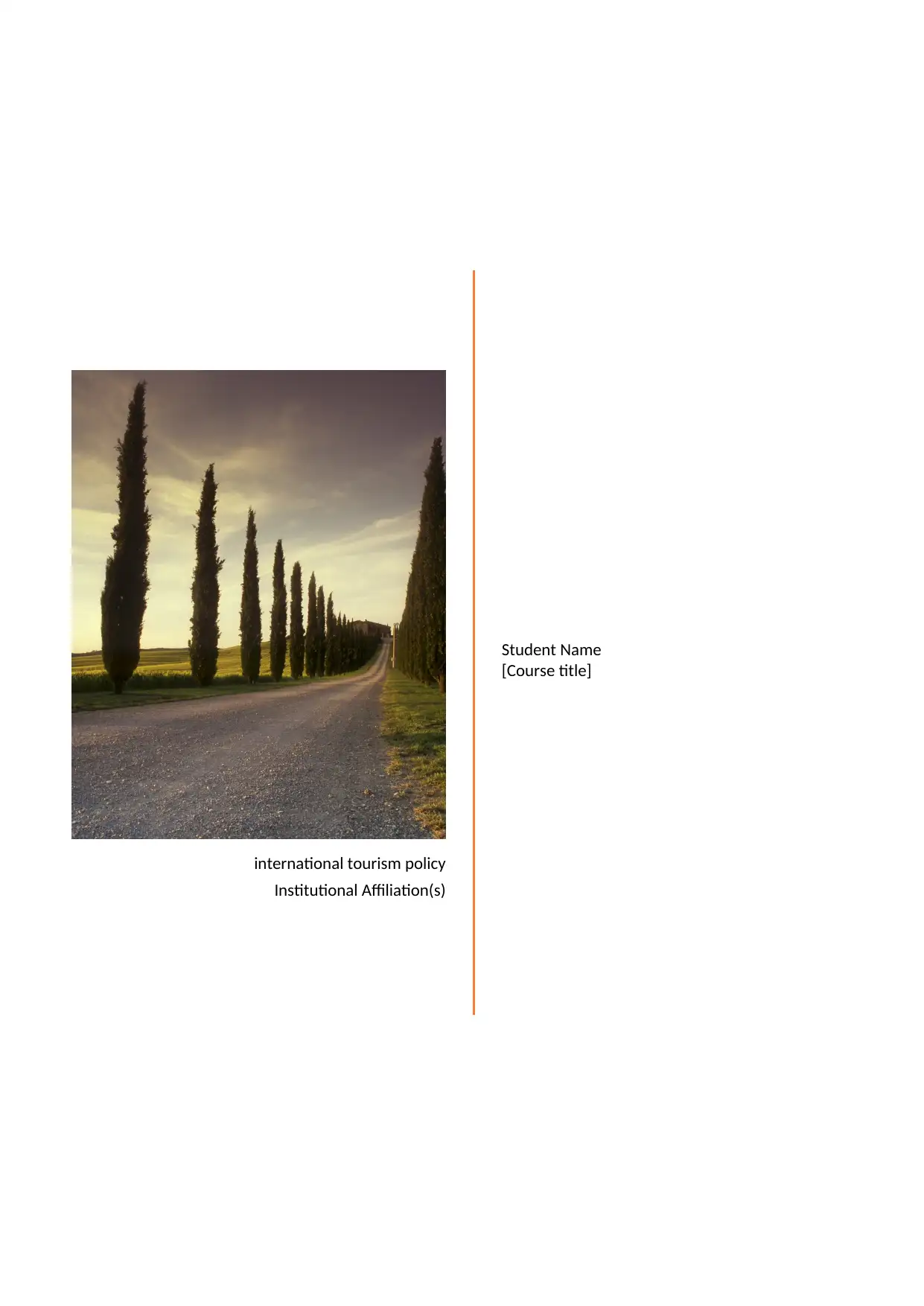
international tourism policy
Institutional Affiliation(s)
Student Name
[Course title]
Institutional Affiliation(s)
Student Name
[Course title]
Paraphrase This Document
Need a fresh take? Get an instant paraphrase of this document with our AI Paraphraser
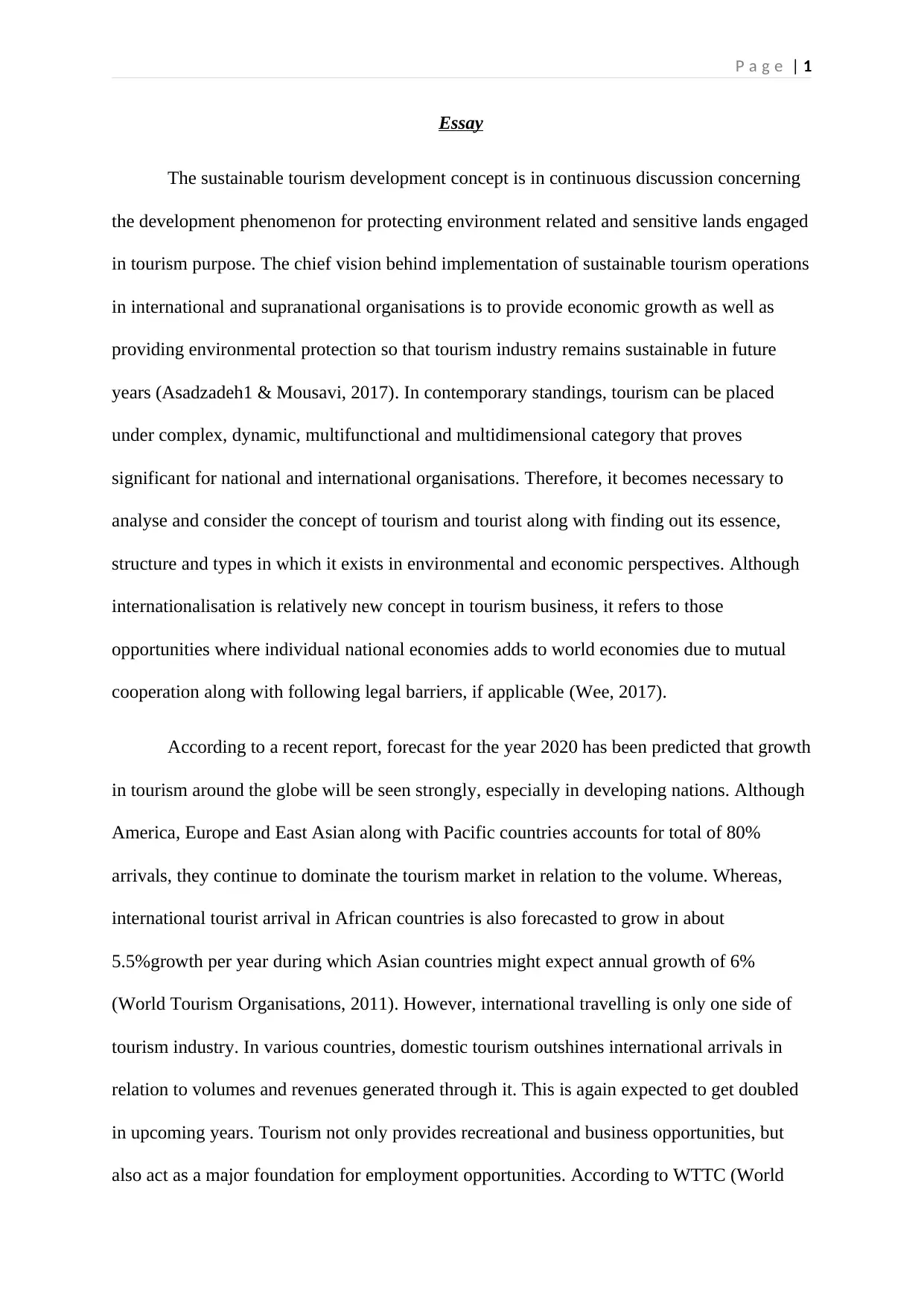
P a g e | 1
Essay
The sustainable tourism development concept is in continuous discussion concerning
the development phenomenon for protecting environment related and sensitive lands engaged
in tourism purpose. The chief vision behind implementation of sustainable tourism operations
in international and supranational organisations is to provide economic growth as well as
providing environmental protection so that tourism industry remains sustainable in future
years (Asadzadeh1 & Mousavi, 2017). In contemporary standings, tourism can be placed
under complex, dynamic, multifunctional and multidimensional category that proves
significant for national and international organisations. Therefore, it becomes necessary to
analyse and consider the concept of tourism and tourist along with finding out its essence,
structure and types in which it exists in environmental and economic perspectives. Although
internationalisation is relatively new concept in tourism business, it refers to those
opportunities where individual national economies adds to world economies due to mutual
cooperation along with following legal barriers, if applicable (Wee, 2017).
According to a recent report, forecast for the year 2020 has been predicted that growth
in tourism around the globe will be seen strongly, especially in developing nations. Although
America, Europe and East Asian along with Pacific countries accounts for total of 80%
arrivals, they continue to dominate the tourism market in relation to the volume. Whereas,
international tourist arrival in African countries is also forecasted to grow in about
5.5%growth per year during which Asian countries might expect annual growth of 6%
(World Tourism Organisations, 2011). However, international travelling is only one side of
tourism industry. In various countries, domestic tourism outshines international arrivals in
relation to volumes and revenues generated through it. This is again expected to get doubled
in upcoming years. Tourism not only provides recreational and business opportunities, but
also act as a major foundation for employment opportunities. According to WTTC (World
Essay
The sustainable tourism development concept is in continuous discussion concerning
the development phenomenon for protecting environment related and sensitive lands engaged
in tourism purpose. The chief vision behind implementation of sustainable tourism operations
in international and supranational organisations is to provide economic growth as well as
providing environmental protection so that tourism industry remains sustainable in future
years (Asadzadeh1 & Mousavi, 2017). In contemporary standings, tourism can be placed
under complex, dynamic, multifunctional and multidimensional category that proves
significant for national and international organisations. Therefore, it becomes necessary to
analyse and consider the concept of tourism and tourist along with finding out its essence,
structure and types in which it exists in environmental and economic perspectives. Although
internationalisation is relatively new concept in tourism business, it refers to those
opportunities where individual national economies adds to world economies due to mutual
cooperation along with following legal barriers, if applicable (Wee, 2017).
According to a recent report, forecast for the year 2020 has been predicted that growth
in tourism around the globe will be seen strongly, especially in developing nations. Although
America, Europe and East Asian along with Pacific countries accounts for total of 80%
arrivals, they continue to dominate the tourism market in relation to the volume. Whereas,
international tourist arrival in African countries is also forecasted to grow in about
5.5%growth per year during which Asian countries might expect annual growth of 6%
(World Tourism Organisations, 2011). However, international travelling is only one side of
tourism industry. In various countries, domestic tourism outshines international arrivals in
relation to volumes and revenues generated through it. This is again expected to get doubled
in upcoming years. Tourism not only provides recreational and business opportunities, but
also act as a major foundation for employment opportunities. According to WTTC (World
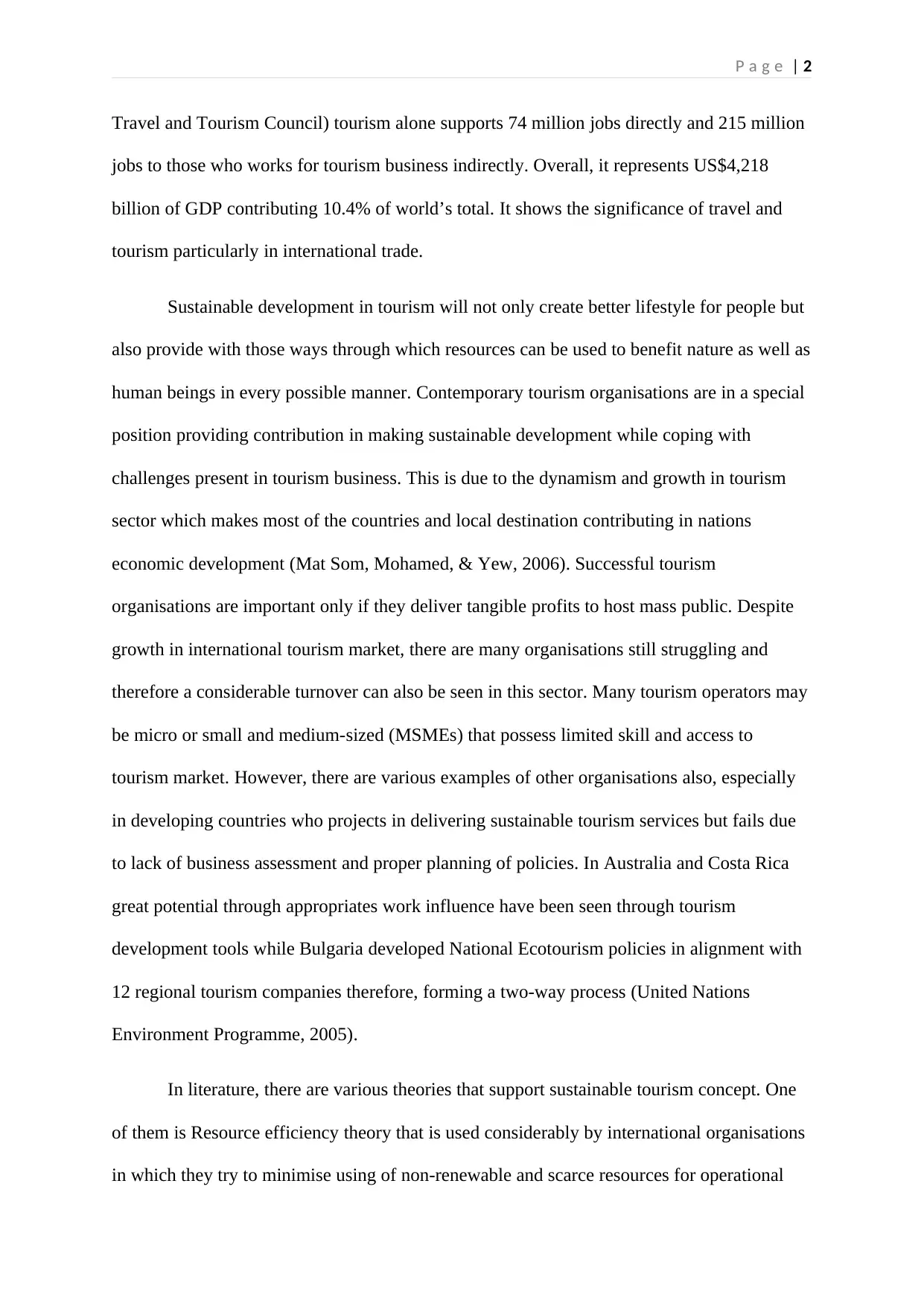
P a g e | 2
Travel and Tourism Council) tourism alone supports 74 million jobs directly and 215 million
jobs to those who works for tourism business indirectly. Overall, it represents US$4,218
billion of GDP contributing 10.4% of world’s total. It shows the significance of travel and
tourism particularly in international trade.
Sustainable development in tourism will not only create better lifestyle for people but
also provide with those ways through which resources can be used to benefit nature as well as
human beings in every possible manner. Contemporary tourism organisations are in a special
position providing contribution in making sustainable development while coping with
challenges present in tourism business. This is due to the dynamism and growth in tourism
sector which makes most of the countries and local destination contributing in nations
economic development (Mat Som, Mohamed, & Yew, 2006). Successful tourism
organisations are important only if they deliver tangible profits to host mass public. Despite
growth in international tourism market, there are many organisations still struggling and
therefore a considerable turnover can also be seen in this sector. Many tourism operators may
be micro or small and medium-sized (MSMEs) that possess limited skill and access to
tourism market. However, there are various examples of other organisations also, especially
in developing countries who projects in delivering sustainable tourism services but fails due
to lack of business assessment and proper planning of policies. In Australia and Costa Rica
great potential through appropriates work influence have been seen through tourism
development tools while Bulgaria developed National Ecotourism policies in alignment with
12 regional tourism companies therefore, forming a two-way process (United Nations
Environment Programme, 2005).
In literature, there are various theories that support sustainable tourism concept. One
of them is Resource efficiency theory that is used considerably by international organisations
in which they try to minimise using of non-renewable and scarce resources for operational
Travel and Tourism Council) tourism alone supports 74 million jobs directly and 215 million
jobs to those who works for tourism business indirectly. Overall, it represents US$4,218
billion of GDP contributing 10.4% of world’s total. It shows the significance of travel and
tourism particularly in international trade.
Sustainable development in tourism will not only create better lifestyle for people but
also provide with those ways through which resources can be used to benefit nature as well as
human beings in every possible manner. Contemporary tourism organisations are in a special
position providing contribution in making sustainable development while coping with
challenges present in tourism business. This is due to the dynamism and growth in tourism
sector which makes most of the countries and local destination contributing in nations
economic development (Mat Som, Mohamed, & Yew, 2006). Successful tourism
organisations are important only if they deliver tangible profits to host mass public. Despite
growth in international tourism market, there are many organisations still struggling and
therefore a considerable turnover can also be seen in this sector. Many tourism operators may
be micro or small and medium-sized (MSMEs) that possess limited skill and access to
tourism market. However, there are various examples of other organisations also, especially
in developing countries who projects in delivering sustainable tourism services but fails due
to lack of business assessment and proper planning of policies. In Australia and Costa Rica
great potential through appropriates work influence have been seen through tourism
development tools while Bulgaria developed National Ecotourism policies in alignment with
12 regional tourism companies therefore, forming a two-way process (United Nations
Environment Programme, 2005).
In literature, there are various theories that support sustainable tourism concept. One
of them is Resource efficiency theory that is used considerably by international organisations
in which they try to minimise using of non-renewable and scarce resources for operational
⊘ This is a preview!⊘
Do you want full access?
Subscribe today to unlock all pages.

Trusted by 1+ million students worldwide
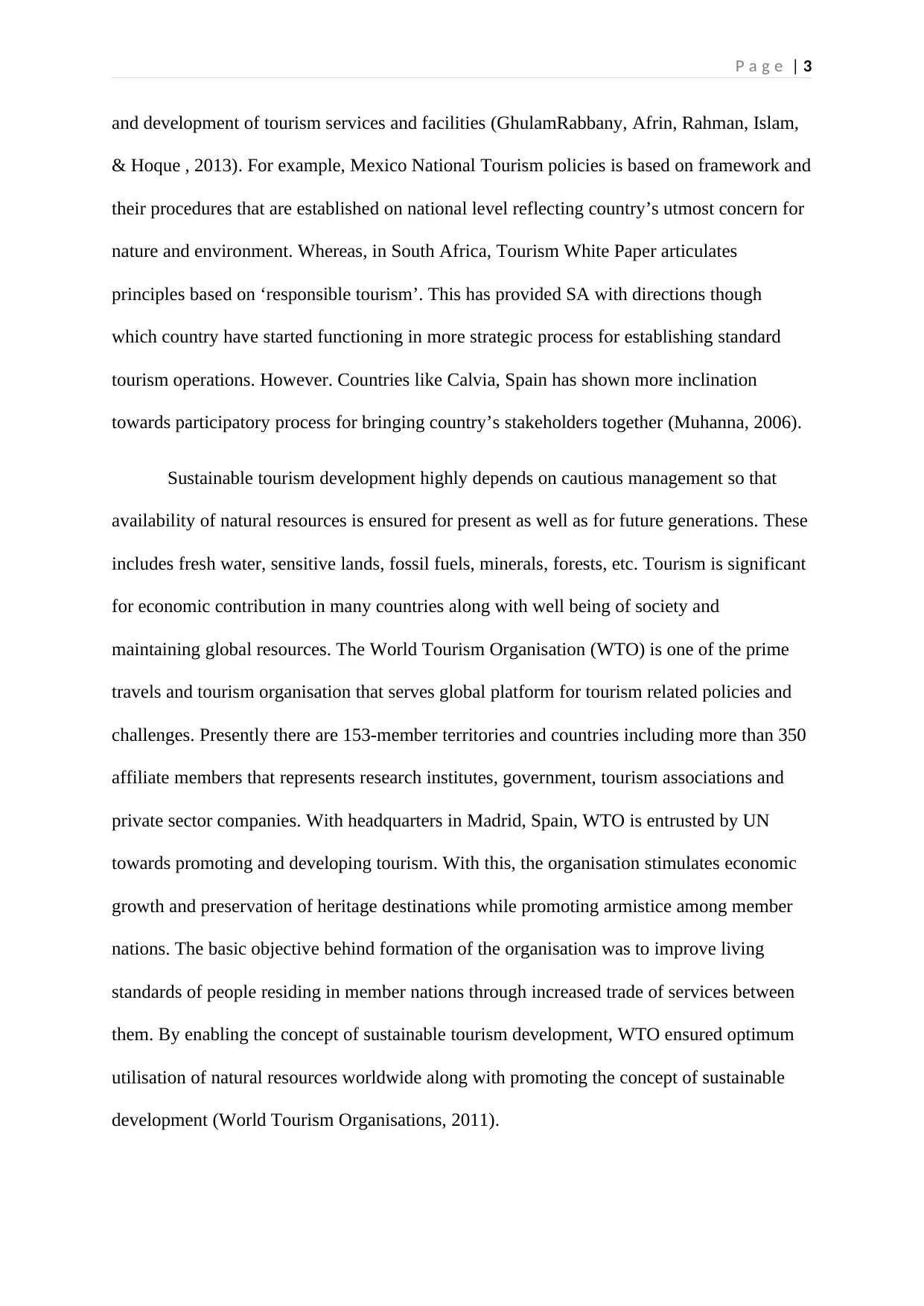
P a g e | 3
and development of tourism services and facilities (GhulamRabbany, Afrin, Rahman, Islam,
& Hoque , 2013). For example, Mexico National Tourism policies is based on framework and
their procedures that are established on national level reflecting country’s utmost concern for
nature and environment. Whereas, in South Africa, Tourism White Paper articulates
principles based on ‘responsible tourism’. This has provided SA with directions though
which country have started functioning in more strategic process for establishing standard
tourism operations. However. Countries like Calvia, Spain has shown more inclination
towards participatory process for bringing country’s stakeholders together (Muhanna, 2006).
Sustainable tourism development highly depends on cautious management so that
availability of natural resources is ensured for present as well as for future generations. These
includes fresh water, sensitive lands, fossil fuels, minerals, forests, etc. Tourism is significant
for economic contribution in many countries along with well being of society and
maintaining global resources. The World Tourism Organisation (WTO) is one of the prime
travels and tourism organisation that serves global platform for tourism related policies and
challenges. Presently there are 153-member territories and countries including more than 350
affiliate members that represents research institutes, government, tourism associations and
private sector companies. With headquarters in Madrid, Spain, WTO is entrusted by UN
towards promoting and developing tourism. With this, the organisation stimulates economic
growth and preservation of heritage destinations while promoting armistice among member
nations. The basic objective behind formation of the organisation was to improve living
standards of people residing in member nations through increased trade of services between
them. By enabling the concept of sustainable tourism development, WTO ensured optimum
utilisation of natural resources worldwide along with promoting the concept of sustainable
development (World Tourism Organisations, 2011).
and development of tourism services and facilities (GhulamRabbany, Afrin, Rahman, Islam,
& Hoque , 2013). For example, Mexico National Tourism policies is based on framework and
their procedures that are established on national level reflecting country’s utmost concern for
nature and environment. Whereas, in South Africa, Tourism White Paper articulates
principles based on ‘responsible tourism’. This has provided SA with directions though
which country have started functioning in more strategic process for establishing standard
tourism operations. However. Countries like Calvia, Spain has shown more inclination
towards participatory process for bringing country’s stakeholders together (Muhanna, 2006).
Sustainable tourism development highly depends on cautious management so that
availability of natural resources is ensured for present as well as for future generations. These
includes fresh water, sensitive lands, fossil fuels, minerals, forests, etc. Tourism is significant
for economic contribution in many countries along with well being of society and
maintaining global resources. The World Tourism Organisation (WTO) is one of the prime
travels and tourism organisation that serves global platform for tourism related policies and
challenges. Presently there are 153-member territories and countries including more than 350
affiliate members that represents research institutes, government, tourism associations and
private sector companies. With headquarters in Madrid, Spain, WTO is entrusted by UN
towards promoting and developing tourism. With this, the organisation stimulates economic
growth and preservation of heritage destinations while promoting armistice among member
nations. The basic objective behind formation of the organisation was to improve living
standards of people residing in member nations through increased trade of services between
them. By enabling the concept of sustainable tourism development, WTO ensured optimum
utilisation of natural resources worldwide along with promoting the concept of sustainable
development (World Tourism Organisations, 2011).
Paraphrase This Document
Need a fresh take? Get an instant paraphrase of this document with our AI Paraphraser
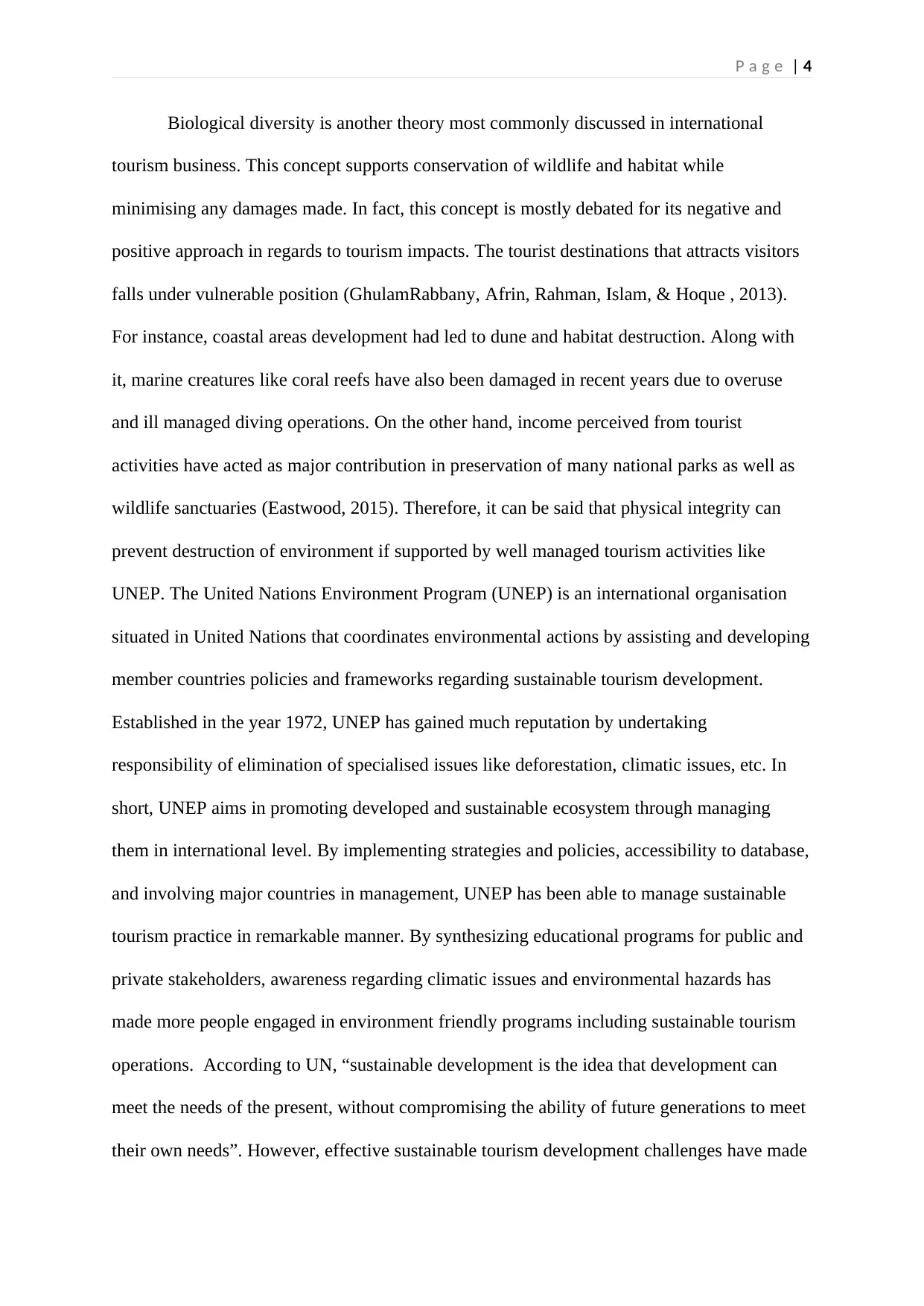
P a g e | 4
Biological diversity is another theory most commonly discussed in international
tourism business. This concept supports conservation of wildlife and habitat while
minimising any damages made. In fact, this concept is mostly debated for its negative and
positive approach in regards to tourism impacts. The tourist destinations that attracts visitors
falls under vulnerable position (GhulamRabbany, Afrin, Rahman, Islam, & Hoque , 2013).
For instance, coastal areas development had led to dune and habitat destruction. Along with
it, marine creatures like coral reefs have also been damaged in recent years due to overuse
and ill managed diving operations. On the other hand, income perceived from tourist
activities have acted as major contribution in preservation of many national parks as well as
wildlife sanctuaries (Eastwood, 2015). Therefore, it can be said that physical integrity can
prevent destruction of environment if supported by well managed tourism activities like
UNEP. The United Nations Environment Program (UNEP) is an international organisation
situated in United Nations that coordinates environmental actions by assisting and developing
member countries policies and frameworks regarding sustainable tourism development.
Established in the year 1972, UNEP has gained much reputation by undertaking
responsibility of elimination of specialised issues like deforestation, climatic issues, etc. In
short, UNEP aims in promoting developed and sustainable ecosystem through managing
them in international level. By implementing strategies and policies, accessibility to database,
and involving major countries in management, UNEP has been able to manage sustainable
tourism practice in remarkable manner. By synthesizing educational programs for public and
private stakeholders, awareness regarding climatic issues and environmental hazards has
made more people engaged in environment friendly programs including sustainable tourism
operations. According to UN, “sustainable development is the idea that development can
meet the needs of the present, without compromising the ability of future generations to meet
their own needs”. However, effective sustainable tourism development challenges have made
Biological diversity is another theory most commonly discussed in international
tourism business. This concept supports conservation of wildlife and habitat while
minimising any damages made. In fact, this concept is mostly debated for its negative and
positive approach in regards to tourism impacts. The tourist destinations that attracts visitors
falls under vulnerable position (GhulamRabbany, Afrin, Rahman, Islam, & Hoque , 2013).
For instance, coastal areas development had led to dune and habitat destruction. Along with
it, marine creatures like coral reefs have also been damaged in recent years due to overuse
and ill managed diving operations. On the other hand, income perceived from tourist
activities have acted as major contribution in preservation of many national parks as well as
wildlife sanctuaries (Eastwood, 2015). Therefore, it can be said that physical integrity can
prevent destruction of environment if supported by well managed tourism activities like
UNEP. The United Nations Environment Program (UNEP) is an international organisation
situated in United Nations that coordinates environmental actions by assisting and developing
member countries policies and frameworks regarding sustainable tourism development.
Established in the year 1972, UNEP has gained much reputation by undertaking
responsibility of elimination of specialised issues like deforestation, climatic issues, etc. In
short, UNEP aims in promoting developed and sustainable ecosystem through managing
them in international level. By implementing strategies and policies, accessibility to database,
and involving major countries in management, UNEP has been able to manage sustainable
tourism practice in remarkable manner. By synthesizing educational programs for public and
private stakeholders, awareness regarding climatic issues and environmental hazards has
made more people engaged in environment friendly programs including sustainable tourism
operations. According to UN, “sustainable development is the idea that development can
meet the needs of the present, without compromising the ability of future generations to meet
their own needs”. However, effective sustainable tourism development challenges have made
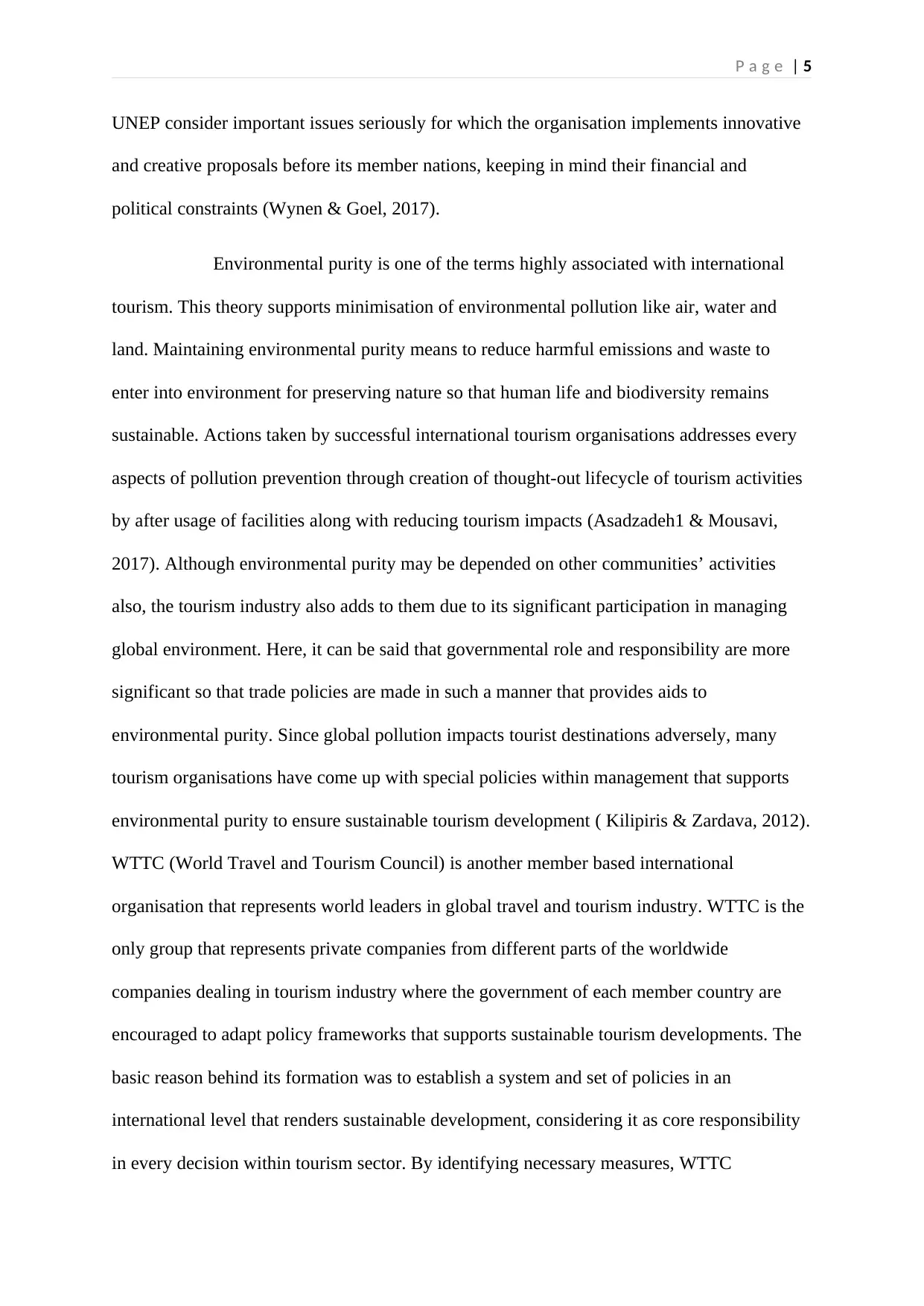
P a g e | 5
UNEP consider important issues seriously for which the organisation implements innovative
and creative proposals before its member nations, keeping in mind their financial and
political constraints (Wynen & Goel, 2017).
Environmental purity is one of the terms highly associated with international
tourism. This theory supports minimisation of environmental pollution like air, water and
land. Maintaining environmental purity means to reduce harmful emissions and waste to
enter into environment for preserving nature so that human life and biodiversity remains
sustainable. Actions taken by successful international tourism organisations addresses every
aspects of pollution prevention through creation of thought-out lifecycle of tourism activities
by after usage of facilities along with reducing tourism impacts (Asadzadeh1 & Mousavi,
2017). Although environmental purity may be depended on other communities’ activities
also, the tourism industry also adds to them due to its significant participation in managing
global environment. Here, it can be said that governmental role and responsibility are more
significant so that trade policies are made in such a manner that provides aids to
environmental purity. Since global pollution impacts tourist destinations adversely, many
tourism organisations have come up with special policies within management that supports
environmental purity to ensure sustainable tourism development ( Kilipiris & Zardava, 2012).
WTTC (World Travel and Tourism Council) is another member based international
organisation that represents world leaders in global travel and tourism industry. WTTC is the
only group that represents private companies from different parts of the worldwide
companies dealing in tourism industry where the government of each member country are
encouraged to adapt policy frameworks that supports sustainable tourism developments. The
basic reason behind its formation was to establish a system and set of policies in an
international level that renders sustainable development, considering it as core responsibility
in every decision within tourism sector. By identifying necessary measures, WTTC
UNEP consider important issues seriously for which the organisation implements innovative
and creative proposals before its member nations, keeping in mind their financial and
political constraints (Wynen & Goel, 2017).
Environmental purity is one of the terms highly associated with international
tourism. This theory supports minimisation of environmental pollution like air, water and
land. Maintaining environmental purity means to reduce harmful emissions and waste to
enter into environment for preserving nature so that human life and biodiversity remains
sustainable. Actions taken by successful international tourism organisations addresses every
aspects of pollution prevention through creation of thought-out lifecycle of tourism activities
by after usage of facilities along with reducing tourism impacts (Asadzadeh1 & Mousavi,
2017). Although environmental purity may be depended on other communities’ activities
also, the tourism industry also adds to them due to its significant participation in managing
global environment. Here, it can be said that governmental role and responsibility are more
significant so that trade policies are made in such a manner that provides aids to
environmental purity. Since global pollution impacts tourist destinations adversely, many
tourism organisations have come up with special policies within management that supports
environmental purity to ensure sustainable tourism development ( Kilipiris & Zardava, 2012).
WTTC (World Travel and Tourism Council) is another member based international
organisation that represents world leaders in global travel and tourism industry. WTTC is the
only group that represents private companies from different parts of the worldwide
companies dealing in tourism industry where the government of each member country are
encouraged to adapt policy frameworks that supports sustainable tourism developments. The
basic reason behind its formation was to establish a system and set of policies in an
international level that renders sustainable development, considering it as core responsibility
in every decision within tourism sector. By identifying necessary measures, WTTC
⊘ This is a preview!⊘
Do you want full access?
Subscribe today to unlock all pages.

Trusted by 1+ million students worldwide
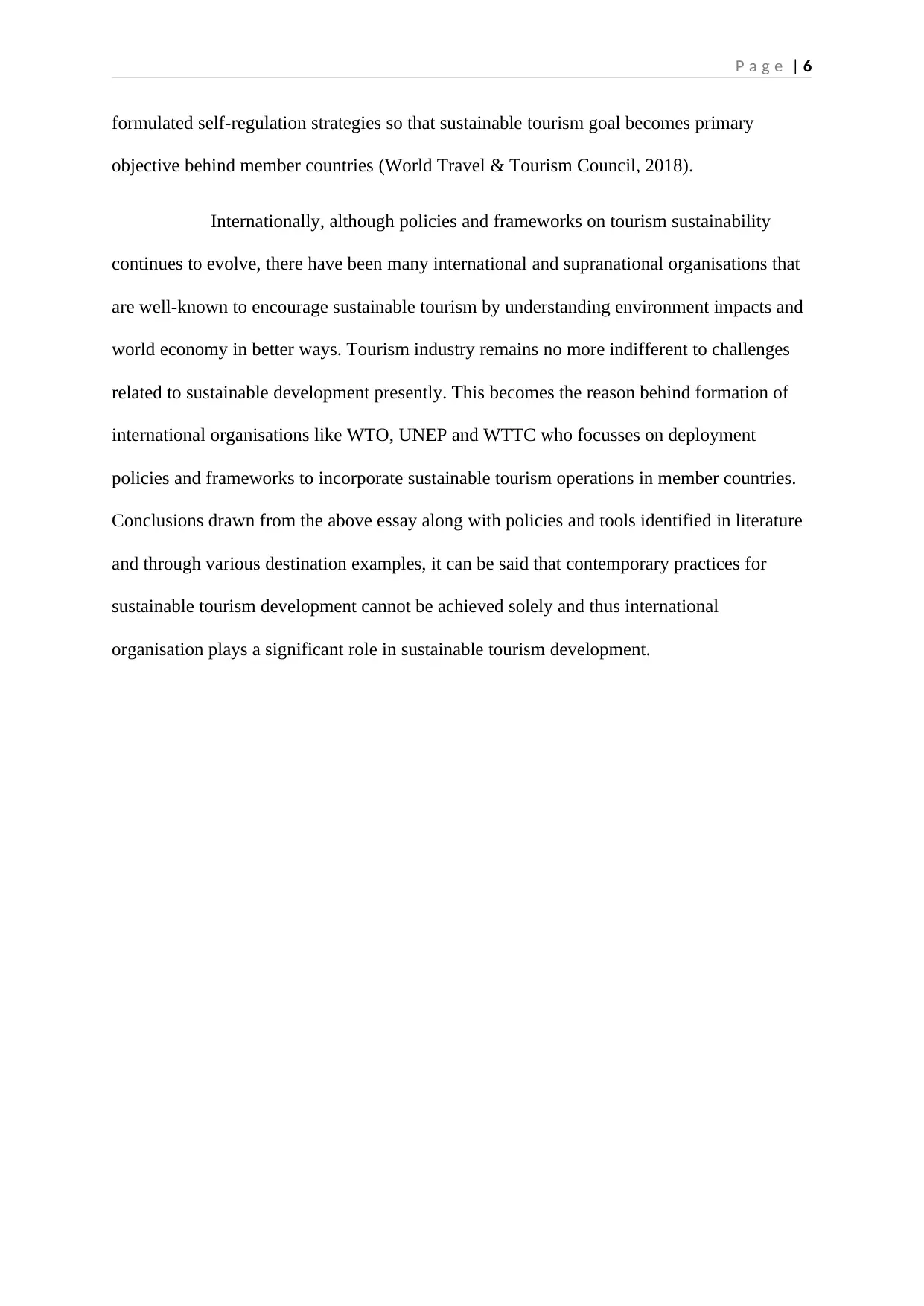
P a g e | 6
formulated self-regulation strategies so that sustainable tourism goal becomes primary
objective behind member countries (World Travel & Tourism Council, 2018).
Internationally, although policies and frameworks on tourism sustainability
continues to evolve, there have been many international and supranational organisations that
are well-known to encourage sustainable tourism by understanding environment impacts and
world economy in better ways. Tourism industry remains no more indifferent to challenges
related to sustainable development presently. This becomes the reason behind formation of
international organisations like WTO, UNEP and WTTC who focusses on deployment
policies and frameworks to incorporate sustainable tourism operations in member countries.
Conclusions drawn from the above essay along with policies and tools identified in literature
and through various destination examples, it can be said that contemporary practices for
sustainable tourism development cannot be achieved solely and thus international
organisation plays a significant role in sustainable tourism development.
formulated self-regulation strategies so that sustainable tourism goal becomes primary
objective behind member countries (World Travel & Tourism Council, 2018).
Internationally, although policies and frameworks on tourism sustainability
continues to evolve, there have been many international and supranational organisations that
are well-known to encourage sustainable tourism by understanding environment impacts and
world economy in better ways. Tourism industry remains no more indifferent to challenges
related to sustainable development presently. This becomes the reason behind formation of
international organisations like WTO, UNEP and WTTC who focusses on deployment
policies and frameworks to incorporate sustainable tourism operations in member countries.
Conclusions drawn from the above essay along with policies and tools identified in literature
and through various destination examples, it can be said that contemporary practices for
sustainable tourism development cannot be achieved solely and thus international
organisation plays a significant role in sustainable tourism development.
Paraphrase This Document
Need a fresh take? Get an instant paraphrase of this document with our AI Paraphraser
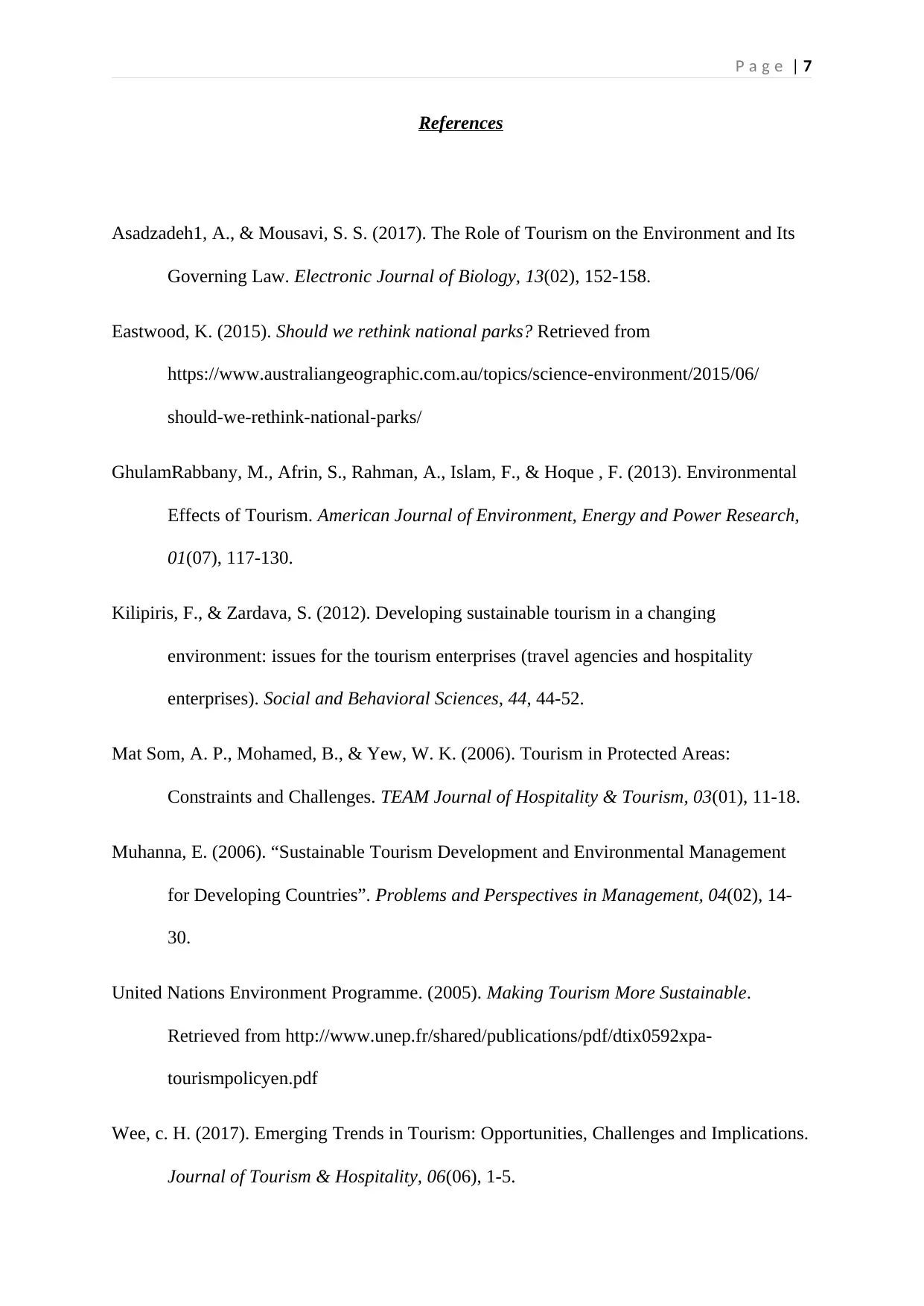
P a g e | 7
References
Asadzadeh1, A., & Mousavi, S. S. (2017). The Role of Tourism on the Environment and Its
Governing Law. Electronic Journal of Biology, 13(02), 152-158.
Eastwood, K. (2015). Should we rethink national parks? Retrieved from
https://www.australiangeographic.com.au/topics/science-environment/2015/06/
should-we-rethink-national-parks/
GhulamRabbany, M., Afrin, S., Rahman, A., Islam, F., & Hoque , F. (2013). Environmental
Effects of Tourism. American Journal of Environment, Energy and Power Research,
01(07), 117-130.
Kilipiris, F., & Zardava, S. (2012). Developing sustainable tourism in a changing
environment: issues for the tourism enterprises (travel agencies and hospitality
enterprises). Social and Behavioral Sciences, 44, 44-52.
Mat Som, A. P., Mohamed, B., & Yew, W. K. (2006). Tourism in Protected Areas:
Constraints and Challenges. TEAM Journal of Hospitality & Tourism, 03(01), 11-18.
Muhanna, E. (2006). “Sustainable Tourism Development and Environmental Management
for Developing Countries”. Problems and Perspectives in Management, 04(02), 14-
30.
United Nations Environment Programme. (2005). Making Tourism More Sustainable.
Retrieved from http://www.unep.fr/shared/publications/pdf/dtix0592xpa-
tourismpolicyen.pdf
Wee, c. H. (2017). Emerging Trends in Tourism: Opportunities, Challenges and Implications.
Journal of Tourism & Hospitality, 06(06), 1-5.
References
Asadzadeh1, A., & Mousavi, S. S. (2017). The Role of Tourism on the Environment and Its
Governing Law. Electronic Journal of Biology, 13(02), 152-158.
Eastwood, K. (2015). Should we rethink national parks? Retrieved from
https://www.australiangeographic.com.au/topics/science-environment/2015/06/
should-we-rethink-national-parks/
GhulamRabbany, M., Afrin, S., Rahman, A., Islam, F., & Hoque , F. (2013). Environmental
Effects of Tourism. American Journal of Environment, Energy and Power Research,
01(07), 117-130.
Kilipiris, F., & Zardava, S. (2012). Developing sustainable tourism in a changing
environment: issues for the tourism enterprises (travel agencies and hospitality
enterprises). Social and Behavioral Sciences, 44, 44-52.
Mat Som, A. P., Mohamed, B., & Yew, W. K. (2006). Tourism in Protected Areas:
Constraints and Challenges. TEAM Journal of Hospitality & Tourism, 03(01), 11-18.
Muhanna, E. (2006). “Sustainable Tourism Development and Environmental Management
for Developing Countries”. Problems and Perspectives in Management, 04(02), 14-
30.
United Nations Environment Programme. (2005). Making Tourism More Sustainable.
Retrieved from http://www.unep.fr/shared/publications/pdf/dtix0592xpa-
tourismpolicyen.pdf
Wee, c. H. (2017). Emerging Trends in Tourism: Opportunities, Challenges and Implications.
Journal of Tourism & Hospitality, 06(06), 1-5.
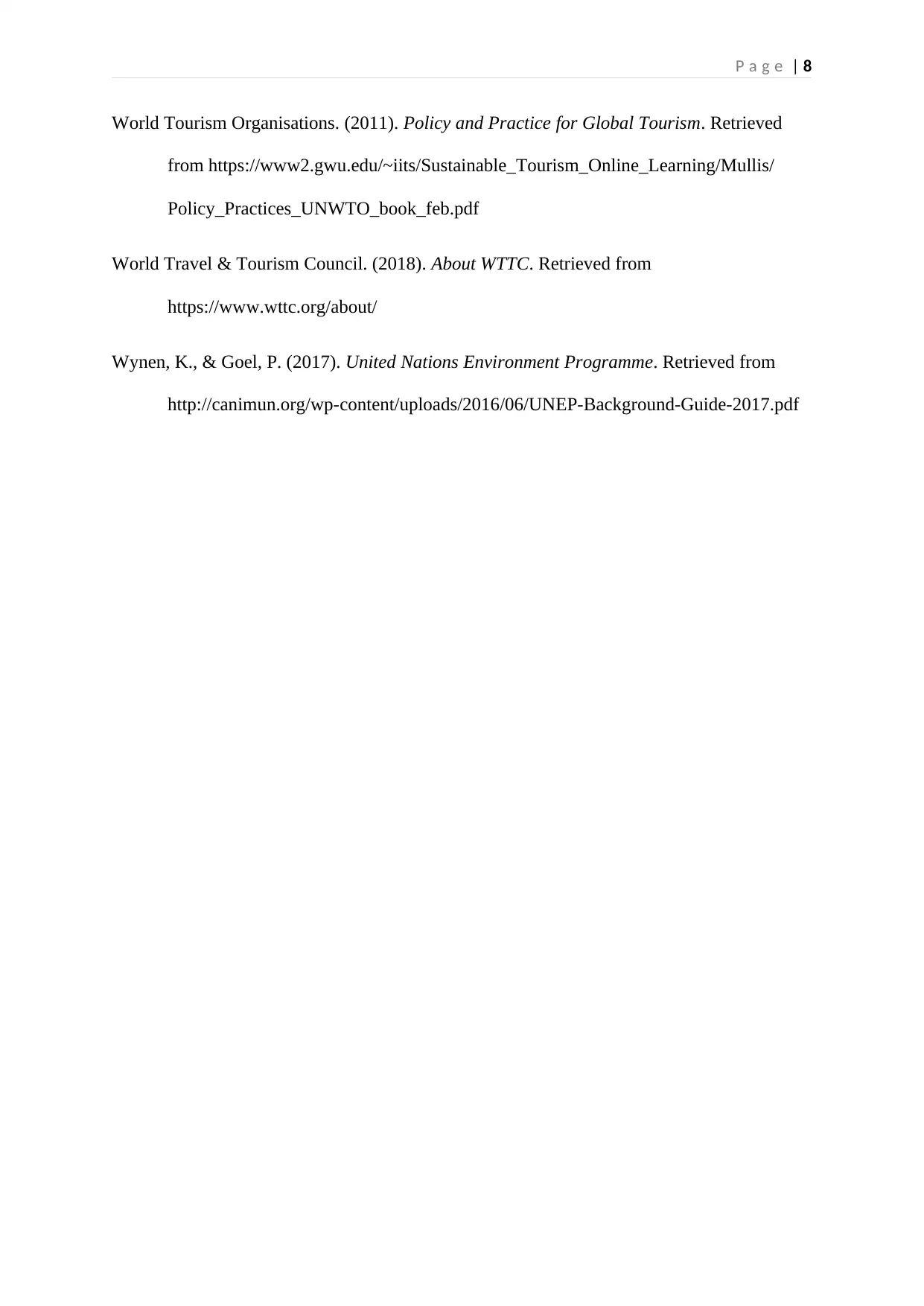
P a g e | 8
World Tourism Organisations. (2011). Policy and Practice for Global Tourism. Retrieved
from https://www2.gwu.edu/~iits/Sustainable_Tourism_Online_Learning/Mullis/
Policy_Practices_UNWTO_book_feb.pdf
World Travel & Tourism Council. (2018). About WTTC. Retrieved from
https://www.wttc.org/about/
Wynen, K., & Goel, P. (2017). United Nations Environment Programme. Retrieved from
http://canimun.org/wp-content/uploads/2016/06/UNEP-Background-Guide-2017.pdf
World Tourism Organisations. (2011). Policy and Practice for Global Tourism. Retrieved
from https://www2.gwu.edu/~iits/Sustainable_Tourism_Online_Learning/Mullis/
Policy_Practices_UNWTO_book_feb.pdf
World Travel & Tourism Council. (2018). About WTTC. Retrieved from
https://www.wttc.org/about/
Wynen, K., & Goel, P. (2017). United Nations Environment Programme. Retrieved from
http://canimun.org/wp-content/uploads/2016/06/UNEP-Background-Guide-2017.pdf
⊘ This is a preview!⊘
Do you want full access?
Subscribe today to unlock all pages.

Trusted by 1+ million students worldwide
1 out of 9
Related Documents
Your All-in-One AI-Powered Toolkit for Academic Success.
+13062052269
info@desklib.com
Available 24*7 on WhatsApp / Email
![[object Object]](/_next/static/media/star-bottom.7253800d.svg)
Unlock your academic potential
Copyright © 2020–2025 A2Z Services. All Rights Reserved. Developed and managed by ZUCOL.





